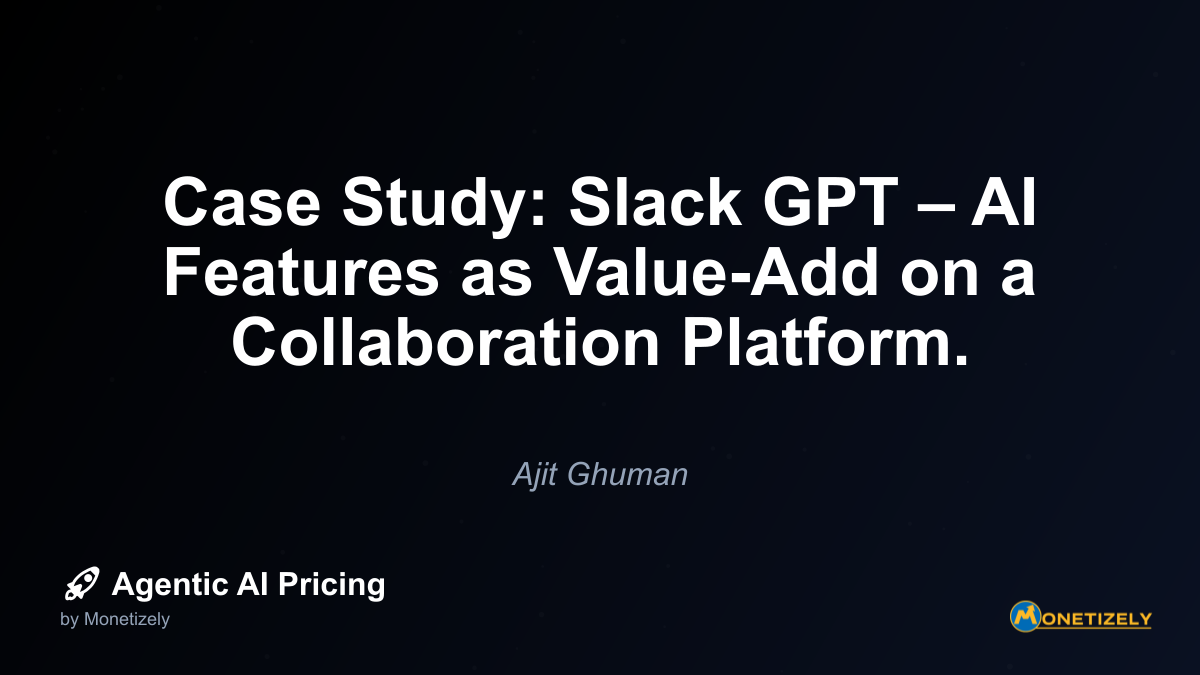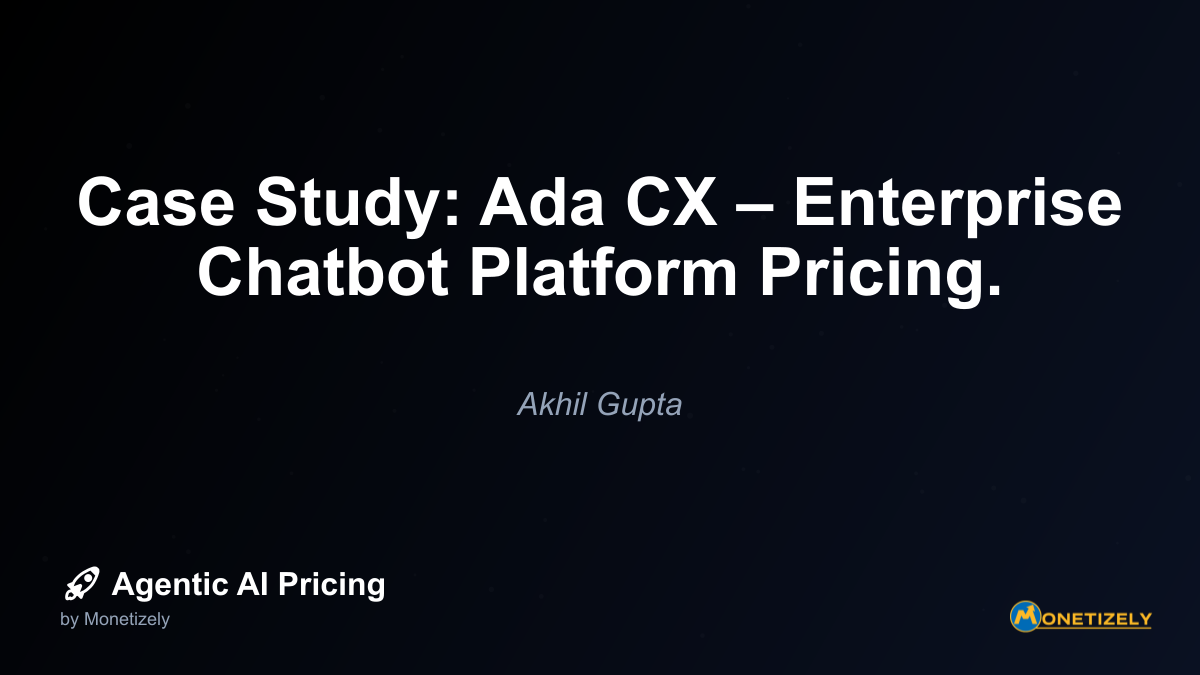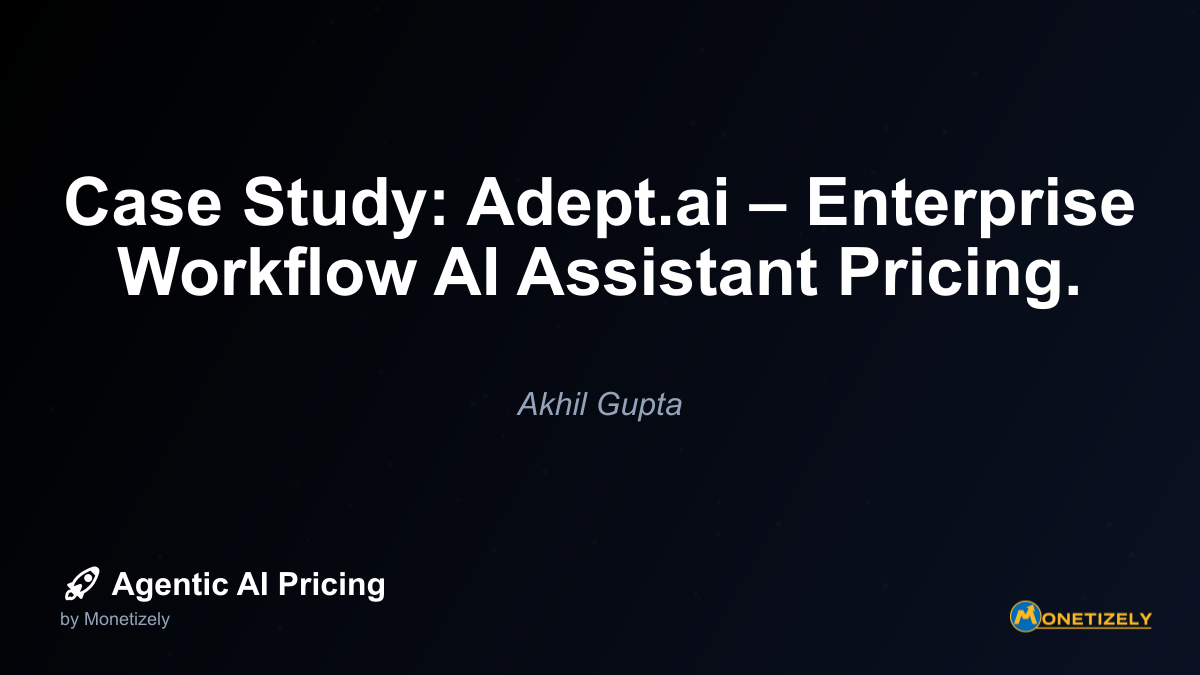· Ajit Ghuman · Case Studies · 11 min read
Case Study: Slack GPT – AI Features as Value-Add on a Collaboration Platform.
AI and SaaS Pricing Masterclass
Learn the art of strategic pricing directly from industry experts. Our comprehensive course provides frameworks and methodologies for optimizing your pricing strategy in the evolving AI landscape. Earn a professional certification that can be imported directly to your LinkedIn profile.

Understanding Slack GPT: What It Is and Why It Matters
Slack GPT represents Slack’s entry into the generative AI space, bringing artificial intelligence capabilities directly into the messaging platform that millions of workers use daily. Announced in 2023, Slack GPT integrates AI-powered features designed to enhance productivity and streamline communication.
Key features of Slack GPT include:
- Channel and thread summaries: Quickly catch up on conversations without reading every message
- AI-powered search: Find information across Slack more efficiently
- Writing assistance: Help drafting messages with appropriate tone and content
- Workflow automation: Simplify repetitive tasks through AI-guided automation
- Knowledge base integration: Connect to company resources to provide context-aware responses
These features address common pain points for Slack users, particularly information overload and the challenge of staying current in busy channels. By offering AI as a solution to these problems, Slack is enhancing its core value proposition of making workplace communication more efficient.
The Value-Add Pricing Strategy: Why Slack Isn’t Charging (Yet)
Slack’s decision to introduce these AI features without initially charging a separate fee represents a strategic pricing approach that warrants analysis. This value-add strategy serves multiple business objectives:
1. Competitive Positioning in a Crowded Market
The collaboration tool market has become increasingly competitive, with Microsoft Teams, Google Workspace, and other platforms continuously adding features. By integrating AI capabilities without an additional charge, Slack maintains competitive parity while potentially creating differentiation through superior implementation.
Microsoft Teams has already integrated various AI features through Microsoft’s broader Copilot initiative. By following suit without additional charges, Slack prevents feature-based customer migration to competitors while maintaining its reputation for user experience excellence.
2. Driving Adoption and Establishing Usage Patterns
Free introduction of AI features allows Slack to drive rapid adoption across its user base. This widespread usage provides several benefits:
- User feedback: Collecting real-world usage data to refine and improve features
- Habit formation: Establishing AI tools as part of users’ daily workflows
- Value demonstration: Showing tangible productivity improvements before monetization
- Network effects: Increasing the value of the platform as more users engage with AI features
By removing the price barrier, Slack maximizes the number of users who will experience these new capabilities, potentially creating dependency that can later support monetization.
3. Tier Differentiation and Upsell Potential
While initially offered across plans, Slack GPT features will likely become differentiated across pricing tiers over time. The company can introduce basic AI features broadly while reserving advanced capabilities for higher-tier plans, creating natural upgrade paths.
This approach follows Slack’s established pattern with features like retention limits, integration capabilities, and security controls. AI features can become powerful motivators for customers to move from free to paid plans, or from standard to enterprise tiers.
4. Data Collection for Product Improvement
AI systems improve with usage and data. By distributing AI features widely, Slack gathers valuable training data and usage patterns that help refine its offerings. This creates a virtuous cycle where free access leads to better products, which increases perceived value and willingness to pay in the future.
The Economics Behind Slack’s AI Strategy
Implementing AI features represents a significant investment for Slack, both in development resources and ongoing operational costs. Understanding these economics helps explain the value-add approach.
Development and Infrastructure Costs
Building AI capabilities requires substantial upfront investment:
- Engineering resources: Developing the AI features and integrating them into the platform
- Model training: Creating and refining the underlying AI models
- Infrastructure: Computing resources to support AI processing
- Ongoing maintenance: Continuous improvement and bug fixes
These costs are largely fixed regardless of how many users adopt the features, creating an incentive to maximize adoption to amortize the investment across the largest possible user base.
Operational Costs and Scaling Considerations
Unlike traditional software features, AI capabilities often incur ongoing costs that scale with usage:
- Inference costs: Computing resources required each time an AI feature is used
- API costs: Payments to third-party AI providers if not fully built in-house
- Storage costs: Managing the data needed for personalized AI experiences
- Compliance and monitoring: Ensuring AI systems operate within acceptable parameters
These variable costs create a more complex economic equation than traditional software features. As usage grows, Slack must balance the value created against the costs incurred.
Long-term Economic Strategy
Slack’s approach suggests a long-term view of AI feature economics:
- Initial subsidization: Absorbing costs to drive adoption and demonstrate value
- Gradual tier differentiation: Moving advanced features to higher-priced tiers
- Efficiency improvements: Reducing per-use costs as technology and scale improve
- Indirect monetization: Using AI features to drive overall platform adoption and retention
This phased approach allows Slack to build market position before optimizing for direct revenue from AI capabilities.
How Slack GPT Fits Into the Broader Platform Strategy
Slack’s AI strategy doesn’t exist in isolation—it’s part of a broader platform evolution that has been ongoing since the company’s founding and accelerated following its acquisition by Salesforce in 2021.
Integration with the Salesforce Ecosystem
Salesforce’s $27.7 billion acquisition of Slack in 2021 positioned the messaging platform as a central hub in Salesforce’s broader business software ecosystem. Slack GPT represents an opportunity to strengthen these connections:
- Data integration: Pulling information from Salesforce and other connected systems
- Cross-platform intelligence: Leveraging AI insights across Salesforce products
- Unified customer view: Creating consistent experiences across touchpoints
These integrations increase the value of both Slack and the broader Salesforce ecosystem, potentially driving revenue through other products even if Slack GPT features remain “free.”
Platform Stickiness and Switching Costs
AI features that learn from company-specific conversations and workflows create personalized experiences that increase switching costs. As users and organizations invest time in training and customizing Slack’s AI capabilities, the perceived cost of migrating to a competitor increases.
This increased lock-in effect has significant lifetime value implications, potentially justifying the initial “free” offering of AI capabilities through increased customer retention and reduced churn.
Expanding the Addressable Market
By enhancing Slack’s capabilities without raising prices, the company potentially expands its addressable market to include:
- Organizations previously priced out: Companies that couldn’t justify premium collaboration tools
- Teams with specific AI needs: Departments with unique requirements addressed by Slack GPT
- Competitors’ customers: Users of other platforms who value AI capabilities
This market expansion strategy focuses on growing the overall user base rather than immediately maximizing revenue per user.
Competitive Landscape: How Other Collaboration Platforms Are Pricing AI
To fully understand Slack’s strategy, it’s helpful to examine how competitors are approaching AI pricing in the collaboration space.
Microsoft Teams and Copilot
Microsoft has taken a different approach with its AI assistant, Microsoft Copilot. The company has positioned Copilot as a premium offering with a separate fee structure:
- Microsoft 365 Copilot: $30 per user per month on top of existing Microsoft 365 licenses
- Integration across applications: Word, Excel, PowerPoint, Outlook, Teams, and more
- Enterprise focus: Initially targeting larger organizations with comprehensive licensing
Microsoft’s approach treats AI as a distinct premium capability rather than a core feature, creating a clear revenue stream but potentially limiting adoption.
This bundling vs. separate pricing dilemma represents one of the key strategic decisions in AI monetization. Slack’s choice to bundle (at least initially) contrasts with Microsoft’s separate premium tier approach.
Google Workspace and Duet AI
Google has positioned its Duet AI capabilities as an add-on to Google Workspace:
- Pricing model: $30 per user per month add-on to existing Workspace licenses
- Feature set: AI assistance across Gmail, Docs, Sheets, Slides, and Meet
- Integration level: Deeply embedded within each application’s workflow
Google’s approach mirrors Microsoft’s, treating AI as a premium capability with direct monetization rather than a bundled feature.
Zoom AI Companion
Zoom has taken a hybrid approach with its AI Companion:
- Basic features: Included at no additional cost for paid Zoom accounts
- Premium features: Reserved for higher-tier plans
- Gradual rollout: Starting with meeting summaries and expanding to additional capabilities
Zoom’s strategy most closely resembles Slack’s, using AI as both a value-add for existing customers and a differentiation point between pricing tiers.
Lessons for SaaS Companies: When to Include AI as a Value-Add
Slack’s approach offers valuable insights for other SaaS companies considering how to price and position AI capabilities.
When the Value-Add Approach Makes Sense
The value-add strategy Slack is employing tends to work best under specific conditions:
- High competitive pressure: When competitors are offering similar capabilities
- Feature parity needs: When AI capabilities are becoming expected baseline functionality
- Network effects potential: When widespread adoption creates platform-wide benefits
- Data collection imperative: When user data improves the core product for everyone
- Clear upsell path: When basic AI features can lead to premium paid features
Companies facing these conditions may benefit from following Slack’s approach of initial inclusion without separate fees.
When Separate Monetization May Be Preferable
Conversely, separate AI pricing makes more sense when:
- Clearly differentiated value: When AI capabilities deliver obvious, measurable ROI
- High per-use costs: When usage expenses are significant and directly attributable
- Limited competitive pressure: When you have unique AI capabilities competitors can’t match
- Targeted use cases: When AI features appeal to specific customer segments willing to pay
- Standalone utility: When AI features work independently from the core product
Companies with these characteristics may be better served by Microsoft and Google’s approach of creating distinct AI tiers.
Hybrid Models and Experimentation
Many companies will find that a hybrid approach works best, with:
- Basic AI features included in all plans
- Advanced AI capabilities in higher tiers
- Premium AI features available as add-ons
- Usage limits that scale with pricing tiers
This flexible approach allows for experimentation to determine which features deliver enough value to support direct monetization.
Implementation Challenges and Considerations
Slack’s value-add approach to AI pricing isn’t without challenges. Several key considerations will influence the success of this strategy:
Managing Computational Costs at Scale
As adoption grows, the computational costs of providing AI features “for free” will increase. Slack will need strategies to manage these costs:
- Efficiency optimizations: Improving models to reduce processing requirements
- Usage limits: Potentially capping free usage while allowing paid upgrades
- Caching and pre-computing: Reducing real-time processing needs
- Local processing: Moving some capabilities to client devices
Without these optimizations, the economics of included AI features may become unsustainable as usage scales.
Balancing Value Perception and Monetization
Slack faces the challenge of eventually monetizing features initially offered for free without creating customer backlash. This requires careful messaging and clear value demonstration:
- Transparent communication: Clearly explaining any future pricing changes
- Grandfathering provisions: Maintaining access for existing users
- Value-based justification: Ensuring any monetized features deliver clear ROI
- Continuous improvement: Adding enough new value to justify pricing changes
This balance between free access and sustainable monetization will be critical to long-term success.
Privacy, Security, and Compliance Considerations
Enterprise customers have significant concerns about AI features, particularly regarding data usage and security:
- Data protection: Ensuring company information isn’t used to train public models
- Compliance requirements: Meeting industry-specific regulations around data handling
- Transparency in processing: Clearly communicating how AI features use customer data
- Control and configuration: Allowing companies to limit AI features when needed
Addressing these concerns is essential for enterprise adoption, regardless of pricing strategy.
The Future of Slack GPT: Potential Monetization Paths
While Slack is currently positioning GPT features as included capabilities, several potential monetization paths may emerge over time:
Tiered Feature Access
The most likely evolution is differentiated AI capabilities across pricing tiers:
- Free tier: Basic summarization and simple assistance
- Standard tier: More advanced writing help and workflow suggestions
- Plus tier: Comprehensive knowledge management and advanced automation
- Enterprise tier: Custom model training and enterprise-specific capabilities
This approach maintains the value-add strategy while creating natural upgrade incentives.
Usage-Based Limitations
Another approach involves setting usage limits that scale with pricing tiers:
- Query limits: Capping the number of AI interactions per user/month
- Processing allowances: Limiting the amount of content processed
- Response quality: Offering more detailed or higher-quality responses at higher tiers
- Speed prioritization: Providing faster processing for premium customers
This usage-based approach aligns costs with revenue while maintaining the perception of included features.
Premium AI Add-Ons
Slack could also develop specialized AI capabilities as separate add-ons:
- Industry-specific assistants: AI trained for legal, healthcare, financial services, etc.
- Advanced analytics: Deeper insights into communication patterns and productivity
- Custom training: Organization-specific AI tuning and optimization
- Developer capabilities: AI-powered tools for Slack app developers
These specialized offerings could command premium pricing while basic features remain included.
Conclusion: Strategic Implications of Slack’s Value-Add Approach
Slack’s decision to introduce Slack GPT as an included feature rather than a separate revenue stream represents a strategic bet on the long-term value of AI-enhanced collaboration. This approach prioritizes adoption, competitive positioning, and platform growth over immediate revenue generation.
For Slack, this strategy aligns with its broader goals of becoming an indispensable hub for work communication and maintaining its position against larger competitors like Microsoft. By embedding AI capabilities throughout the platform without additional charges, Slack removes adoption barriers while potentially creating new differentiation points.
For the broader SaaS industry, Slack’s approach highlights the tension between treating AI as a premium capability versus a core feature. As AI becomes more ubiquitous, companies will need to carefully consider where their AI capabilities fall on this spectrum and price accordingly.
The success of Slack’s strategy will ultimately depend on several factors:
- How effectively the AI features solve real user problems
- How well Slack manages the computational costs as usage scales
- Whether the company can eventually monetize advanced capabilities without disrupting user experience
- How competitors respond with their own AI pricing strategies
As the collaboration market continues to evolve, Slack’s value-add approach to AI pricing provides a compelling case study in how SaaS companies can navigate the complex intersection of product strategy, competitive positioning, and revenue optimization in the age of AI.
Co-Founder & CEO
Ajit is the author of Price To Scale, a top book on SaaS Pricing and is the Founder of Monetizely. Ajit has led and worked in pricing and product marketing at firms like Twilio, Narvar and Medallia. His work has been featured in Forbes and VentureBeat. Ajit regularly consults with software companies from Seed stage to post-IPO on pricing strategy. Ajit is also a highly-rated co-instructor for 'The Art of SaaS Pricing and Monetization' on Maven.
Pricing Strategy Audit
Let our experts analyze your current pricing strategy and identify opportunities for improvement. Our data-driven assessment will help you unlock untapped revenue potential and optimize your AI pricing approach.




